Nature Notes
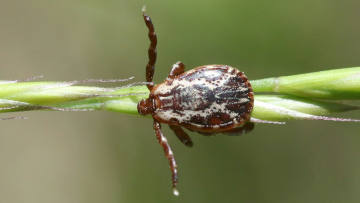
PHOTO COURTESY OF GARRY KESSLER
Dog tick perching on vegetation
July 5.2024
NATURE NOTES
By Annie Reid
Westborough Community Land Trust
Tick check season – for 3 local ticks
Time for a tick check! It’s that moment when a family or a solo walker, or a gardener, stops to check for ticks on clothing and skin. But today’s tick check is informational. Do you know our local ticks? They include the usual two, informally called dog ticks and deer ticks, plus one that’s new to our area, the lone star tick. They all can transmit serious diseases to us.
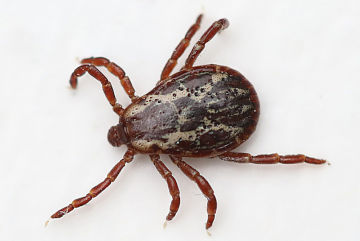
PHOTO COURTESY OF GARRY KESSLER
American dog tick (male)
First, the dog tick. In our area it’s usually the American dog tick (Dermcentor variabilis). You’re most likely to spot this tick because the adult is relatively large, about 3/4- inch. It’s also the most common tick in our area. You might find it on a pet such as a dog, or on yourself or a child, especially May-August. As with all ticks, the previous life stages are smaller, so they’re much harder to see, find, and recognize. Male and female adult ticks look a bit different, but the key thing is to recognize a tick and remove it.
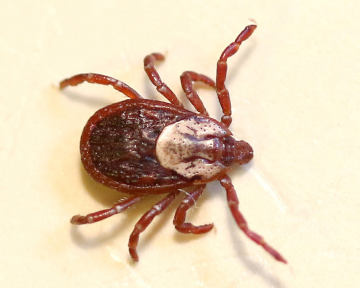
PHOTO COURTESY OF GARRY KESSLER
American dog tick (female)
How does a dog tick, or any tick, get on you? By perching. A tick perches on grass or low vegetation, waiting for an animal (such as a dog, deer, fox, coyote, raccoon, or human) to brush against the greenery so the tick can crawl on. Notice that adult ticks have 8 legs. (Spiders also have 8 legs, but the spiders’ legs all seem to stick out from one central point.) Spiders jump, but ticks crawl. (Beetles, flies, bees, butterflies, and more have 6 legs). Ticks don’t fly.
Next, the deer tick or black-legged tick (Ixodes scapularis). It’s well known for transmitting lyme disease. At 1/2-inch or less, the adult deer tick is small and hard to spot. Deer ticks are so called because of the role that white-tailed deer (Odocoileus virginianus) often play in their life cycle, but mice such as white-footed mice (Peromyscus leucopus) also play a major role. Basically, deer ticks get lyme disease bacteria from mice and give them to deer and humans.
The life cycle of ticks seems complicated to us. All ticks go through four life stages: egg, larva, nymph, and adult. In those last three stages, they need to feed on blood – or die. They can get it from mammals, birds, or even reptiles or amphibians. Ticks often attach to different animals at different life stages.
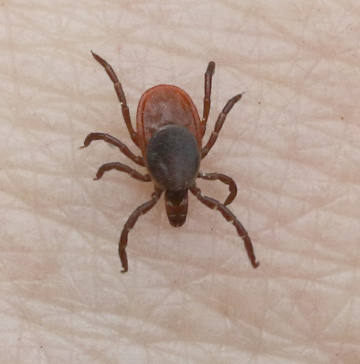
PHOTO COURTESY OF GARRY KESSLER
Deer tick or black-legged tick (female)
Take the deer tick’s 2-year life cycle. It starts in May, with a mass of eggs (1,500-2,000) laid on the ground or on leaves by a female deer tick, which then dies.
Then, in late summer, larvae (the first immature stage) hatch and search for a blood meal. About the size of a period, deer tick larvae usually feed on small animals, such as mice, other rodents (voles, shrews, chipmunks, rats), even birds. White-footed mice often carry the bacteria (Borrelia burgdorferi) that cause lyme disease, but without being harmed by the bacteria. The mice serve as a “reservoir” of the bacteria. Deer tick larvae acquire the bacteria when they feed on infected mice. When full, the larvae drop off the mice. When freezing weather arrives, deer tick larvae overwinter in leaf litter.
In the following spring, the deer tick larvae become nymphs (the next immature stage), about the size of a poppy seed. Nymphs are most active, searching for blood, in spring and early summer (April-July). Most people get infected during this time. Infected nymphs can spread the lyme disease bacteria to deer, humans, and other “host” animals. After a blood meal, nymphs drop off. They develop into adults in late summer.
Adult deer ticks are most active in the fall (October-December) and again in the following spring (April-May). They’re about the size of a sesame seed. They need to feed on blood to fuel their reproduction. Be aware that they are more likely than other ticks to remain somewhat active in winter. Watch out for them on mild winter days.
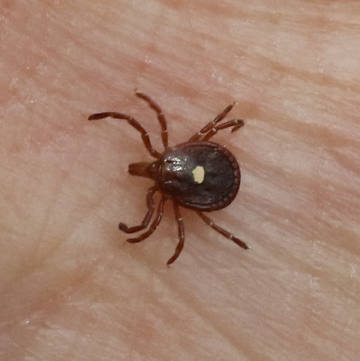
PHOTO COURTESY OF GARRY KESSLER
Lone star tick (female) with distinctive white spot. This spot differs from the whitish “shield” you might notice at one end of female dog ticks.
Finally, there’s also the newcomer, the lone star tick (Amblyomma americanum). This tick gets its common name from the white spot on the back of adult females. (The name has no relation to Texas, the lone star state.) Until recently, New Jersey was the northern limit of the lone star tick’s range, but with a warming climate, this tick has been moving northward. In size, both male and female lone star adults are a little more than 1/2-half inch long, in-between dog-tick size and deer-tick size.
Oddly, the lone star tick can cause humans to develop an allergy to red meat. What happens? This allergy, called “alpha-gal,” develops when the human immune system reacts, or perhaps overreacts, to a certain non-human mammalian carbohydrate (alpha-gal, or galactose-alpha-1,3-galactose) passed along by the lone star tick’s bite. This tick can also transmit other serious diseases.
Do ticks have predators? Do any animals eat them? The answer is yes. Certain beetles, spiders, and ants prey on ticks. Many birds eat ticks, including wild turkeys, robins, bluejays, chickens, and other birds that forage on the ground. Small animals that spend a lot of time on the ground, such as squirrels and chipmunks, eat ticks that try to attach to them.
Beyond that, opossums (Didelphis virginiana) are famous as tick eaters. They’re said to be able to eat 5,000 ticks per season. (Yes, we have opossums – our only marsupial – in local woods https://westboroughlandtrust.org/nn/nn263). They groom themselves thoroughly, killing 95 percent of the ticks they find.
How can you protect yourself from ticks and still enjoy the great outdoors? Prevention is the best strategy. One major step is to cover up: wear long sleeves, long pants, closed shoes, and socks – and tuck your pant legs into your socks. Covering up will protect you from ticks, mosquitoes, sunlight, and poison ivy. Another key step is to become good at doing frequent tick checks on your clothes and skin. Remove any ticks you find. (Deer ticks generally need to be attached for more than 24 hours to transmit the lyme disease bacteria.) Finally, check with your veterinarian for advice about the best measures for protecting pets.
If you want to know what diseases the ticks in our area can spread to humans, here’s a list:
-
American dog tick: Rocky Mountain Spotted Fever (Rickettsia rickettsii); Tularemia (Francisella tularensis).
-
Deer (black-legged) tick: Lyme Disease (Borrelia burgdorferi); Human Babesiosis (Babesia microti); Human Anaplasmosis (Anaplasma phagocytophilum); Powassan virus; Deer Tick virus; Hard tick relapsing fever (Borrelia miyamotoi).
- Lone star tick: Human Ehrlichiosis (Ehlichia chaffeensis, E. ewingii); Tularemia (Francisella tularensis).
For more about tick checks and tick-borne diseases in Massachusetts: https://www.mass.gov/doc/how-to-do-a-tick-check-0/download and https://www.mass.gov/info-details/tick-borne-disease-prevention.
Stay safe as you enjoy nature this summer, and think about the interconnections among the life around us.